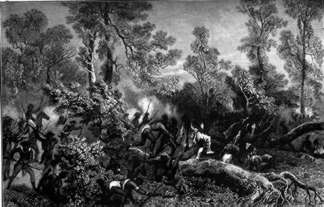1794- Battle of Fallen Timbers

After the rout of General St. Clair, President Washington appointed General Wayne to the task of pacifying the Indians of the Northwest. Wayne assembled a force of 4,000 men. He trained his men well and moved cautiously, building forts as he went. Finally, Wayne met the Indians near a British fort on the Maumee River. There, in a clearing known as Fallen Timbers, he decisively defeated the Indians; clearing the way for a peace treaty the following year that effectively ceded all of today's Ohio to the settlers.
After General St. Clair's defeat, Washington appointed General Anthony Wayne to lead an expedition against the Native Americans in the Northwest. Wayne, known for his meticulous planning, was ready by late autumn of 1793. He led his forces into Indian Territory and established a winter camp at Greenville, where he continuously trained his men and sent them on scouting missions. He then built Fort Recovery and Fort Defiance. At the St. Mary’s River, he constructed Fort Adams. Finally, in August 1794, he advanced as far as the Maumee River with 3,000 men.
Wayne offered to negotiate with the Native Americans, but they, emboldened by their previous victories and support from the British, requested 10 days to decide. Wayne, believing they were stalling for time, chose to attack. The Native Americans made their stand in an area damaged by a hurricane the previous year, where fallen trees created a natural barrier. Wayne's well-trained troops, however, proved effective, and the Native American line broke under the pressure of a determined military force led by a strong leader.
After his victory, Wayne destroyed Indian villages and as much corn as he could find, moving deeper into Indian Territory and establishing Fort Wayne before returning to winter quarters in Greenville. The following summer, various Native American tribes convened in Greenville to negotiate a treaty. The treaty resulted in the tribes ceding twenty-five thousand square miles of territory in exchange for $25,000 in goods and an annual payment of $10,000 to the tribes that observed the agreement.
At the treaty signing ceremony, Wayne expressed his hope for a lasting peace and friendship, and for the enlightenment of the Native Americans, envisioning a future where their children could cultivate the land and enjoy the fruits of peace and industry.
This treaty paved the way for settlers to establish homes throughout the Northwest Territory.
 >
>